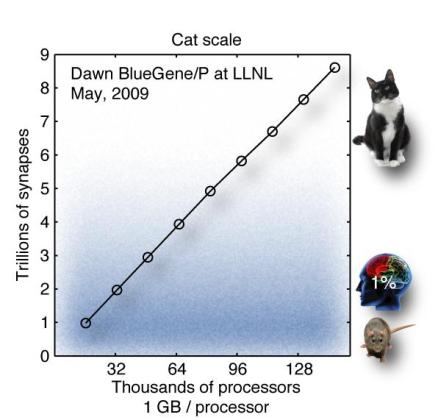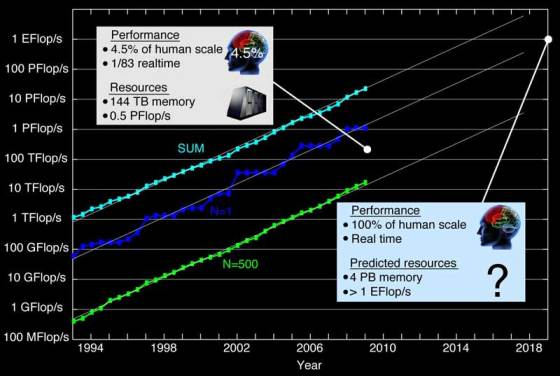147000 CPUs are “as smart as a cat” – IBM Research simulates cat’s brain
 At SC 09, the supercomputing conference, IBM announced significant progress toward creating a computer system that simulates and emulates the brain’s abilities for sensation, perception, action, interaction and cognition, while rivaling the brain’s low power and energy consumption and compact size. The cognitive computing team, led by IBM Research, in collaboration with colleagues from Lawrence Berkeley National Lab, has performed the first near real-time cortical simulation of the brain that exceeds the scale of a cat cortex (PDF) and contains 1 billion spiking neurons and 10 trillion individual learning synapses.
At SC 09, the supercomputing conference, IBM announced significant progress toward creating a computer system that simulates and emulates the brain’s abilities for sensation, perception, action, interaction and cognition, while rivaling the brain’s low power and energy consumption and compact size. The cognitive computing team, led by IBM Research, in collaboration with colleagues from Lawrence Berkeley National Lab, has performed the first near real-time cortical simulation of the brain that exceeds the scale of a cat cortex (PDF) and contains 1 billion spiking neurons and 10 trillion individual learning synapses.
Additionally, in collaboration with researchers from Stanford University, IBM scientists have developed an algorithm that exploits the Blue Gene supercomputing architecture in order to non-invasively measure and map the connections between all cortical and sub-cortical locations within the human brain using magnetic resonance diffusion weighted imaging. Mapping the wiring diagram of the brain is crucial to untangling its vast communication network and understanding how it represents and processes information.
These advancements will provide a unique workbench for exploring the computational dynamics of the brain, and stand to move the team closer to its goal of building a compact, low-power synaptronic chip using nanotechnology and advances in phase change memory and magnetic tunnel junctions. The team’s work stands to break the mold of conventional von Neumann computing, in order to meet the system requirements of the instrumented and interconnected world of tomorrow.
As the amount of digital data that we create continues to grow massively and the world becomes more instrumented and interconnected, there is a need for new kinds of computing systems – imbued with a new intelligence that can spot hard-to-find patterns in vastly varied kinds of data, both digital and sensory; analyze and integrate information real-time in a context-dependent way; and deal with the ambiguity found in complex, real-world environments.
Businesses will simultaneously need to monitor, prioritize, adapt and make rapid decisions based on ever-growing streams of critical data and information. A cognitive computer could quickly and accurately put together the disparate pieces of this complex puzzle, while taking into account context and previous experience, to help business decision makers come to a logical response.
“Learning from the brain is an attractive way to overcome power and density challenges faced in computing today,” said Josephine Cheng, IBM Fellow and lab director of IBM Research – Almaden. “As the digital and physical worlds continue to merge and computing becomes more embedded in the fabric of our daily lives, it’s imperative that we create a more intelligent computing system that can help us make sense the vast amount of information that’s increasingly available to us, much the way our brains can quickly interpret and act on complex tasks.”
To perform the first near real-time cortical simulation of the brain that exceed the scale of the cat cortex, the team built a cortical simulator that incorporates a number of innovations in computation, memory, and communication as well as sophisticated biological details from neurophysiology and neuroanatomy. This scientific tool, akin to a linear accelerator or an electron microscope, is a critical instrument used to test hypotheses of brain structure, dynamics and function. The simulation was performed using the cortical simulator on Lawrence Livermore National Lab’s Dawn Blue Gene/P supercomputer with 147,456 CPUs and 144 terabytes of main memory.
When combined with the cortical simulator, the algorithm allows scientists to experiment with various mathematical hypotheses of brain function and structure of how structure affects function as they work toward discovering the brain’s core computational micro and macro circuits.
After the successful completion of Phase 0, IBM and its university partners were recently awarded $16.1M in additional funding from DARPA for Phase 1 of DARPA’s Systems of Neuromorphic Adaptive Plastic Scalable Electronics (SyNAPSE) initiative. This phase of research will focus on the components, brain-like architecture and simulations to build a prototype chip. The long-term mission of IBM’s cognitive computing initiative is to discover and demonstrate the algorithms of the brain and deliver low-power, compact cognitive computers that approach mammalian-scale intelligence and use significantly less energy than today’s computing systems.
Dharmendra Modha, manager of cognitive computing for IBM Research and senior author of the paper, called it a “truly unprecedented scale of simulation”. In his Cognitive Computing blog, Modha stated that a simulation of a human cortex could come within the next decade if Moore’s Law holds. That’s the rule of thumb that the number of transistors on a computer chip tends to double every two years. Although praising the IBM Research project, Jim Olds, a neuroscientist and director of the Krasnow Institute for Advanced Study at George Mason University, cautioned that simulating the human brain is “such a complex problem that we may not be able to get to an answer, even with supercomputing”.











The research has many potentials, but is it me or every DARPA funded project brings us closer to real-life Terminators?
Human Brain and Animal Brain Vs Brain Used Computer — Which will win?